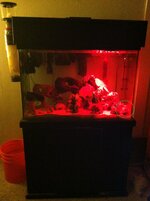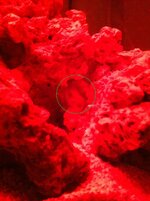Quantity of food wanted, is best for them and is a healthy amount are all separate questions and almost every keeper has a different answer on how to to about feeding them.
I'll start with how we determine how much and when to feed and then give a couple other opinions by successful keepers.
We feed our late juvenile/adult octos 6 days a week, one meal a day in the largest size they will fully eat (hatchlings and young juveniles are fed daily but still only once, twice or more may be better for hatchlings). This takes a little experimentation. IME, they will not over eat at a single sitting and any uneaten food should be removed when no longer held captive in their webbing (sometimes you may have to fight to retrieve empty shells ). The fast day comes from a combination of prior seahorse keeping, comments by Roy on reducing food intake (or possibly frequency) to extend life expectency and the eating habits of our first few octopuses. Quantity will vary from octopus to octopus and not necessarily by species. You may find, particularly as they near senesence, that you need to decrease food size or feed every other day if food is not accepted on a regular basis (not a single incident). Once they know their feeding time, the larger animals are smart enough to try to get your attention if you are late or if they are still hungry. Establishing a feeding corner or spot is good for this mutual understanding. LittleBit and Octavia want to eat every day and neither was/is happy with the fast day (often broken and a small portion of something provided usually followed by the human comment, "but she was LOOKING at me!"). Octane (same species as Octavia but male) would eat a large table shrimp 4 times a week but then fast on his own with some variation but roughly every 3rd or 4th day. He had no interest in food on his self imposed fast days but would still be active and interact. I find that starting with something about the volume of the eye (so something long and skinny would be bigger than a chunk of something more solid - krill vs piece of table shrimp) while they are small seems to be a good starting place. You should see 30-60 minutes of eating time where it is obviously concentrating on its food and not moving about the tank. Others will suggest mantle size (more in length than in volume I think). Once he is taking food regularly (PLEASE REREAD MY POST AT #2), you can offer a second piece after the first is taken (even if not yet eaten) to see if there is an interest. Alternately, you might start giving increasingly larger amounts until the food is not consumed and then scale back slightly (we use both approaches depending on the animal). If you see your snail and/or hermit clean-up crew disappearing, you may want to increase the amount you feed. I have found that snails and hermits are often left alone once octos are fully acclimated and accustomed to the food slave providing an easy meal. The one exception to this was our vulgaris. LittleBit would eat anything she could find but did not want seconds at feeding time.
). The fast day comes from a combination of prior seahorse keeping, comments by Roy on reducing food intake (or possibly frequency) to extend life expectency and the eating habits of our first few octopuses. Quantity will vary from octopus to octopus and not necessarily by species. You may find, particularly as they near senesence, that you need to decrease food size or feed every other day if food is not accepted on a regular basis (not a single incident). Once they know their feeding time, the larger animals are smart enough to try to get your attention if you are late or if they are still hungry. Establishing a feeding corner or spot is good for this mutual understanding. LittleBit and Octavia want to eat every day and neither was/is happy with the fast day (often broken and a small portion of something provided usually followed by the human comment, "but she was LOOKING at me!"). Octane (same species as Octavia but male) would eat a large table shrimp 4 times a week but then fast on his own with some variation but roughly every 3rd or 4th day. He had no interest in food on his self imposed fast days but would still be active and interact. I find that starting with something about the volume of the eye (so something long and skinny would be bigger than a chunk of something more solid - krill vs piece of table shrimp) while they are small seems to be a good starting place. You should see 30-60 minutes of eating time where it is obviously concentrating on its food and not moving about the tank. Others will suggest mantle size (more in length than in volume I think). Once he is taking food regularly (PLEASE REREAD MY POST AT #2), you can offer a second piece after the first is taken (even if not yet eaten) to see if there is an interest. Alternately, you might start giving increasingly larger amounts until the food is not consumed and then scale back slightly (we use both approaches depending on the animal). If you see your snail and/or hermit clean-up crew disappearing, you may want to increase the amount you feed. I have found that snails and hermits are often left alone once octos are fully acclimated and accustomed to the food slave providing an easy meal. The one exception to this was our vulgaris. LittleBit would eat anything she could find but did not want seconds at feeding time.
Roy and Joe-Ceph (correct me if I misstate please) feed every 2 to 3 days (this is specific to their cold water bimaculoides but the concept is thought to be beneficial to all octos and I believe CaptFish takes a similar but modified approach with his warm water animals) and allow the animals to have more food than they will consume but remove the uneaten (alive or dead) after a period of time (I am thinking an hour but would prefer you verify with them if they don't post a confirmation).
A third approach that is useful for newly introduced animals that are not yet eating but has seen success for the life of the animal is to leave a quantity of "extra" live food in the tank at all times, offering a regular meal but leaving food to hunt if the animal is hungry. I believe Carol uses pretty much this approach with crabs.
Keeping a supply of small crustaceans (pods) in the tank seems to be a good idea and gives them something to hunt. We feed our tanks Cyclop-eze (primarily for the serpent stars, mushrooms, polyps and gorgonians) and see that the octos are eating it (color of their elimination) but don't know if they eat it directly (we know this is the case for the O. mercatoris dwarf) or if they eat it indirectly through the pods.
I have seemingly noticed but not documented (the antecdotal "thought" may be totally invalid) that females may brood quicker if well satiated and it might be better to keep them a bit hungry and possibly disrupt the tank purposfully once they are adult/late juveniles. I wish we could test the theory as it might help keep females alive longer in aquariums but it may be only wishful thinking that pushes this "observation". It is also menatlly very difficult NOT to offer food when they are making a show of bring hungry.
I'll start with how we determine how much and when to feed and then give a couple other opinions by successful keepers.
We feed our late juvenile/adult octos 6 days a week, one meal a day in the largest size they will fully eat (hatchlings and young juveniles are fed daily but still only once, twice or more may be better for hatchlings). This takes a little experimentation. IME, they will not over eat at a single sitting and any uneaten food should be removed when no longer held captive in their webbing (sometimes you may have to fight to retrieve empty shells
Roy and Joe-Ceph (correct me if I misstate please) feed every 2 to 3 days (this is specific to their cold water bimaculoides but the concept is thought to be beneficial to all octos and I believe CaptFish takes a similar but modified approach with his warm water animals) and allow the animals to have more food than they will consume but remove the uneaten (alive or dead) after a period of time (I am thinking an hour but would prefer you verify with them if they don't post a confirmation).
A third approach that is useful for newly introduced animals that are not yet eating but has seen success for the life of the animal is to leave a quantity of "extra" live food in the tank at all times, offering a regular meal but leaving food to hunt if the animal is hungry. I believe Carol uses pretty much this approach with crabs.
Keeping a supply of small crustaceans (pods) in the tank seems to be a good idea and gives them something to hunt. We feed our tanks Cyclop-eze (primarily for the serpent stars, mushrooms, polyps and gorgonians) and see that the octos are eating it (color of their elimination) but don't know if they eat it directly (we know this is the case for the O. mercatoris dwarf) or if they eat it indirectly through the pods.
I have seemingly noticed but not documented (the antecdotal "thought" may be totally invalid) that females may brood quicker if well satiated and it might be better to keep them a bit hungry and possibly disrupt the tank purposfully once they are adult/late juveniles. I wish we could test the theory as it might help keep females alive longer in aquariums but it may be only wishful thinking that pushes this "observation". It is also menatlly very difficult NOT to offer food when they are making a show of bring hungry.



